July 2011 Archives
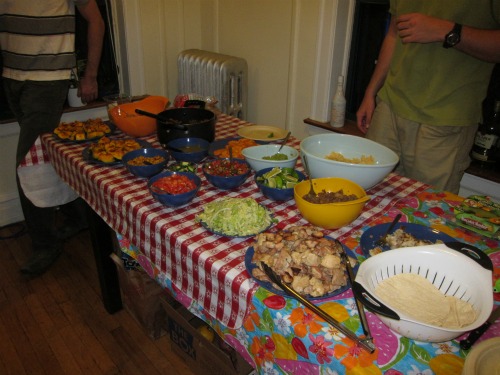
Some people run to chocolate for comfort—others crave chicken noodle soup or that dish their mother always made when they were growing up. Unlike these people, I want salsa. And guacamole. And fresh corn tortillas. As summer kicks off and the heat attempts to melt us all, I thought what better way to raise spirits and appease palates than with a taco night. So I invited some friends over and spent a day cooking up some Mexican favorites: refried beans, Mexican rice, and tacos of three varieties (mojo chicken, garlic chili tilapia, and beef). I made the event eco-friendly by:
- Cooking with local produce and using ingredients I already had in my pantry
- Using the oven as sparingly as possible—I put the food in while it was preheating and cooked the yams, squash, and chicken simultaneously
- Buying compostable plates, recycled paper napkins, and Preserve plastic cups, which are reusable and ultimately recyclable; forks weren’t really necessary but my daintier guests used silverware

The spread turned out really well, thanks to help from some great friends, but by the end of the evening I was more impressed with my guests than my own culinary endeavors. What did they do to impress me? Compost!
- I labeled three collection bags—Recycling, Compost, and Trash and noted what should go into each receptacle (I wrote this on scrap paper, of course).
- I only put one small bag out for trash and had much larger receptacles for recycling and compost; the bin for compost was the largest.
- At the end of the night, there were 10 pounds of compost (!), three overflowing bags of recycling, and one small not-quite-full brown bag of trash (this includes the trash all the party preparations!)
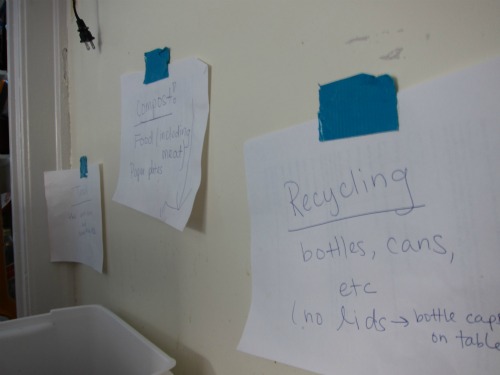
The story doesn’t stop with the end of the party. In order for the eco-friendly trend to continue I had to reuse and recycle the leftover food. I gave the meat to a coworker, made a frittata with leftover jalapeños and tomatoes, and I plan to use the tortilla crumbs for tortilla soup or tortilla coated chicken. The food that wasn’t opened I returned to the grocery stores. Here are some recipes in case you have some extras from a south of the border night:
One note about jalapeños: be very careful when handling them. I had a terrible experience involving my face feeling like it was one fire that I would wish upon no one. Wear gloves when you cut them! The oil is dangerous and you should NOT get it near your face.
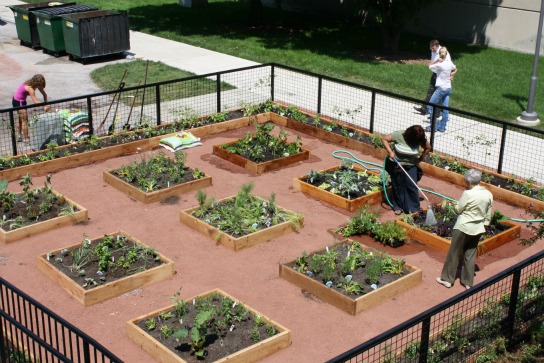
The Smart Museum, Facilities Services, and Court Theatre have formed an unprecedented collaboration—converting a dormant green space for a project called “Avant Garden.” University staff and interns volunteered to transform a large empty lot between the Young Building and Smart Museum into a common space for interaction, production, and innovation. Thanks to the efforts of volunteers from the three departments, the plot sprung to life within a matter of hours.
The Office of Sustainability convened volunteers from Smart, Court and Facilities to work together sowing the space. Many volunteers lingered to admire their work; proud of their efforts and the resulting beauty of the space. University community members passing by stopped to inquire about Avant Garden and spent time with the volunteers.
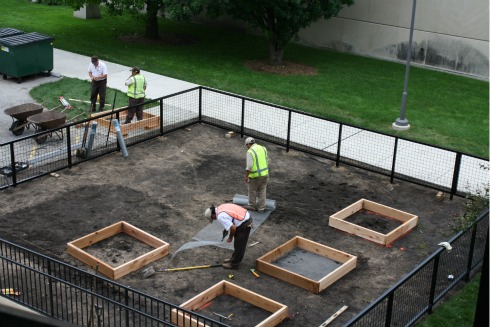
Avant Garden’s designer, Kathleen Golomb, is currently a Facilities Services intern. She previously managed the planters along Michigan Avenue and has appeared in episodes of PBS’ P. Allen Smith’s Garden Home. Her plan for the space was to make it both functional and beautiful: while the herbs and vegetables will be harvested, she strategically placed the plants in locations that emphasize their aesthetic qualities.
We hope the space will serve as encouragement to the campus community to consider the many ways that green space can be enhanced, utilized, and valued. The benefits of this uncommon collaboration will continue to grow and evolve, just like Avant Garden.
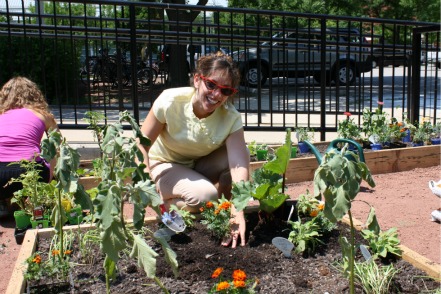
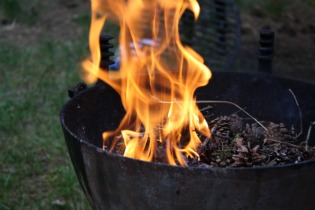
As these past few weeks have made obvious to most Chicago residents, we have finally joined the world in celebrating everyone’s favorite season: summer. Yes, it’s time to stow away that down coat and start donning that pair of Ray Bans you’ve been keeping in the dark all winter. And what better ways to celebrate 80 degree temps than with long days on the beach, and, of course, one of America’s favorite culinary traditions—grilling.
But before you fire up the grill or stock up on propane and beef, here are some important things to consider:
- The Main Dish: America runs on meat, especially when we think about putting things on the grill. One way to lessen your carbon footprint is to increase the amount of veggies you grill. Remember? Corn on the cobb, peppers, eggplant, zucchini, pineapple, asparagus, onions, mushrooms, tomatoes, and potatoes are all easy additions for a barbeque feast. Also consider serving a salad filled with locally grown vegetables and fruit. While we all know that beef consumption is not quite environmentally friendly, you can lessen your footprint by buying grass-fed beef—or substitute extra firm tofu in any recipe that calls for meat.
- The Act of Grilling: As you stand over that smoking grill, try closing the hood. This will increase the efficiency of the grill and allow the food within to cook more evenly.
- Dessert: While finishing off a barbeque with an apple pie a la mode might seem like a brilliant (and traditional) plan, consider making a blueberry cobbler or having grilled peaches, apples, or pears a la mode instead. Ovens are so energy inefficient that a residential oven design has yet to gain the Energy Star label. So, for a real treat, throw a fruit cobbler in a foil pan on the barbeque as coals are burning out—as far as the environment is concerned, that’s free energy!.
- Serving the finished product: Sure, those summer-themed plastic plates with their festive colors and bright designs might be tempting, but thinking about them sitting in a landfill isn’t so exciting. So instead of buying plastic ware, save some money and the environment by providing barbeque-goers with reusable silverware and plates. Not only will these options help keep your costs down; they will also keep your grilled goods warmer for longer. If lugging your grandmother’s finest porcelain out to the park doesn’t sound appealing, try buying Reusable Preserve tableware. This plastic ware is sturdy, lightweight, and dishwasher safe so you can reuse them at your next party or backyard gathering.
- Choosing a Grill: If you’re the market for a new grill, deciding between propane and charcoal can be a daunting task. Using charcoal briquettes might be the most sustainable option considering that they’re made from waste products, but the choice isn’t so clear-cut. For more about the pro’s and con’s, click here.
Whatever you’re throwing on the barbie this summer, we wish you and yours a delicious and safe celebration of food, sun, and all other excellent things that announce the presence of summer.
Palmer, Brian. “Fire Up the Grill, Not the Atmosphere.” Editorial. New York Times. 29 June 2011. Web. http://www.nytimes.com/2011/06/30/opinion/30palmer.html?_r=1. Silver, Rebecca. “How to Go Green: Barbecues.” TreeHugger. 19 Feb. 2007. Web. 07 July 2011. http://www.treehugger.com/files/2007/02/how-to-go-green-barbecues.php.
Photo source: http://en.wikipedia.org/wiki/File:Preparinggrillforgrilling,grillwithflamesandcones.jpg
